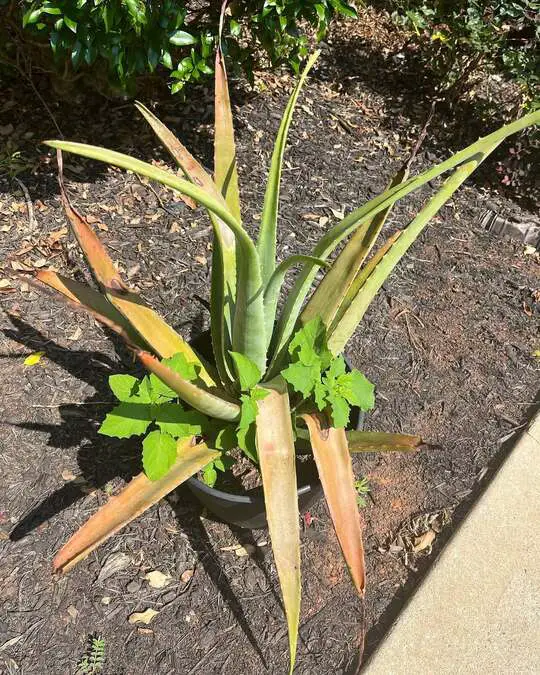Aloe vera is a resilient succulent loved for its easy care and health benefits. Knowing how to tell when it’s time to water aloe vera is essential to keep this plant thriving. Overwatering or underwatering can both harm the plant, so recognizing signs of its water needs is key.
This guide helps you identify the perfect watering schedule for your aloe vera by understanding its natural habits and visual cues. With proper watering, your aloe vera will stay healthy, vibrant, and ready to provide its soothing gel whenever you need it.

Signs Your Aloe Vera Needs Water
Leaf Appearance and Texture
One of the most noticeable signs that your aloe vera needs water is the change in its leaves. When aloe vera is thirsty, its leaves become thinner, wrinkled, or curling inward. Healthy leaves should be plump and firm because they store water inside. If you notice your plant’s leaves losing their firmness or developing brown tips, it’s a clear indicator that it requires hydration.
Soil Condition Check
Checking the soil moisture is an easy and reliable way to know when to water aloe vera. Aloe prefers well-draining soil and should be watered only when the top 1-2 inches of soil feel completely dry to the touch. Overly dry soil can stress the plant, but consistently soggy soil leads to root rot. Using a moisture meter or simply inserting your finger into the soil helps determine if it’s time to water.
Plant Behavior and Growth Patterns
Aloe vera plants that are not watered enough may show slowed growth or become droopy. Unlike many plants, aloe vera stores water in its leaves and uses it gradually, so signs of dehydration often appear slowly. If you notice a dull color or the leaves starting to lean or flop, this is another signal your plant is thirsty and needs a drink.
- Key signs summary:
- Thin, wrinkled, or curling leaves
- Dry, crumbly soil top layer
- Slowed growth and drooping leaves
Monitoring these signs regularly helps maintain your aloe vera’s health and prevents damage from underwatering.
The Role of Soil Moisture in Watering Aloe Vera
Importance of Well-Draining Soil
Aloe vera thrives in soil that drains quickly, preventing water from lingering around the roots. Proper soil moisture balance is vital because aloe roots are prone to rot if kept too wet. Ideal soil for aloe contains sand, perlite, or small gravel to enhance drainage. Without this, excess moisture can suffocate roots, leading to fungal infections and poor plant health.
Monitoring Soil Moisture Levels
Keeping track of soil moisture is essential in determining when to water aloe vera. The soil should be allowed to dry out almost completely between waterings. A practical way is to check the top 1-2 inches of soil with your finger or a moisture meter. If this layer is dry, it’s time to water; if it still feels moist, wait a few more days. This approach ensures the plant receives adequate hydration without overwatering.
Effects of Soil Moisture on Plant Health
- Too wet: Roots may rot, causing yellowing leaves and eventual plant death.
- Too dry: Leaves become shriveled and dry, signaling dehydration.
- Balanced moisture: Promotes healthy root function and vibrant, plump leaves.
Maintaining the right soil moisture is crucial for aloe vera’s longevity and vitality, making it a cornerstone of effective watering practices.
Temperature and Light’s Effect on Watering
How Temperature Influences Water Needs
Temperature plays a crucial role in determining how often you should water your aloe vera. In warmer months or climates, aloe vera’s water requirements increase because heat speeds up soil drying and plant transpiration. Conversely, during cooler months, especially in winter, the plant enters a semi-dormant state and uses water more slowly, meaning you should reduce watering frequency to avoid waterlogging.
Light Exposure and Its Impact
Aloe vera thrives in bright, indirect sunlight. The amount of light your plant receives directly affects its water consumption. In high light conditions, the plant grows faster and loses water through its leaves more quickly, requiring more frequent watering. In low-light environments, the aloe’s growth slows, and water use decreases, so watering less often is necessary to prevent root rot.
Tips for Adjusting Watering Based on Environment
- Increase watering frequency in temperatures above 70°F (21°C) with plenty of sunlight.
- Reduce watering during temperatures below 60°F (15°C) or when sunlight is minimal.
- Use shade cloth or move plants indoors during extreme heat to prevent stress.
- Monitor soil moisture more frequently during seasonal transitions to adjust watering accordingly.
Understanding how temperature and light affect aloe vera’s water needs helps maintain a balanced watering routine and promotes healthy growth year-round.
How Humidity Impacts Aloe Vera’s Watering Schedule
Aloe Vera’s Adaptation to Dry Environments
Aloe vera is naturally adapted to arid, low-humidity environments where water is scarce. Its thick, fleshy leaves store water to survive dry conditions. In high humidity, the plant loses less water through transpiration, meaning it requires less frequent watering. Conversely, in very dry air, aloe vera uses its stored water faster and needs more regular hydration.
Adjusting Watering Based on Humidity Levels
When humidity is high (above 60%), the soil retains moisture longer, and aloe vera’s water absorption slows down. Overwatering becomes a risk if you do not adjust your schedule accordingly. In low humidity conditions (below 40%), water evaporates faster from both soil and leaves, so aloe vera may need watering more often to replenish lost moisture.
- High humidity effects:
- Soil stays moist longer
- Risk of root rot increases if watered too frequently
- Watering intervals should be extended
- Low humidity effects:
- Faster soil drying
- Increased transpiration rates
- More frequent watering necessary
Practical Tips for Humidity Management
- Use a hygrometer to monitor indoor humidity near your plant.
- In humid climates, ensure excellent drainage and avoid daily watering.
- In dry climates, consider misting occasionally or grouping plants to raise local humidity slightly.
- Adjust watering based on both soil dryness and leaf condition, not just a fixed schedule.
By tailoring watering habits to humidity levels, you can help your aloe vera maintain optimal health and prevent common watering mistakes.
The Role of Dormancy in Watering Frequency
Understanding Aloe Vera’s Dormant Period
Aloe vera undergoes a natural dormancy phase, typically during colder months or periods of reduced sunlight. During dormancy, the plant’s metabolic processes slow down significantly, and it requires far less water. This is a survival mechanism to conserve resources when growth conditions are not ideal. Watering during this period should be minimal to avoid root rot and overhydration.
Adjusting Watering Frequency During Dormancy
When aloe vera is dormant, watering frequency can be reduced drastically. Instead of watering every 2-3 weeks as in active growth phases, watering once every 4-6 weeks or even less might be sufficient, depending on the indoor climate. It’s important to check soil moisture before watering, ensuring the soil is completely dry to prevent waterlogging.
- Dormant phase watering tips:
- Water sparingly, only when soil is dry several inches deep
- Avoid watering leaves directly to prevent fungal issues
- Reduce fertilization or pause it altogether during dormancy
Recognizing Dormancy Through Plant Behavior
Signs of dormancy include slower growth, paler or slightly wrinkled leaves, and a general lack of new leaf production. If your aloe vera displays these symptoms, it’s a cue to decrease watering and allow the plant to rest. Resuming normal watering can begin when new growth appears in spring or warmer months.
Properly managing watering during dormancy ensures your aloe vera stays healthy year-round without the risks associated with overwatering.
Using the Soak and Dry Method for Aloe Vera Watering
What is the Soak and Dry Method?
The soak and dry method is a watering technique perfectly suited for succulents like aloe vera. It involves thoroughly watering the plant until excess water drains from the pot’s bottom, then allowing the soil to dry out completely before the next watering. This mimics the natural conditions aloe vera experiences in the wild, where rain is sporadic but heavy, followed by long dry spells.
Benefits of Soak and Dry for Aloe Vera
- Prevents overwatering: Allowing soil to dry fully reduces the risk of root rot, a common problem with aloe vera.
- Promotes healthy root development: Deep watering encourages roots to grow downward, seeking moisture, which strengthens the plant’s stability.
- Maintains optimal moisture balance: This method ensures the plant has enough water without keeping the soil soggy, supporting vibrant, plump leaves.
How to Apply the Soak and Dry Method
- Use a well-draining pot and soil mix designed for succulents.
- Water generously until you see water flow from the drainage holes.
- Empty the saucer to avoid standing water.
- Wait until the top 1-2 inches of soil feel completely dry before watering again.
- Adjust frequency depending on season, temperature, and humidity (typically every 2-4 weeks).
This approach helps your aloe vera thrive by aligning watering habits with its natural water storage and conservation mechanisms.
The Benefits of a Moisture Meter
Accurate Soil Moisture Measurement
A moisture meter provides a precise reading of the soil’s moisture level, eliminating guesswork when watering aloe vera. Unlike relying solely on touch or visual cues, a moisture meter measures moisture deeper in the root zone, helping you determine if the soil is truly dry or still retains enough water. This accuracy prevents both overwatering and underwatering, which are common issues for succulent care.
Easy to Use and Time-Saving Tool
Using a moisture meter is simple and quick. You just insert the probe into the soil and get an immediate moisture reading. This saves time compared to manual checks and avoids the trial-and-error approach that can stress your aloe vera. Many meters come with a color-coded dial or digital display, making it user-friendly even for beginners.
- Key advantages:
- Helps maintain ideal soil moisture levels
- Prevents root rot caused by excess water
- Encourages healthier and more vibrant aloe leaves
Long-Term Plant Health and Cost Efficiency
Consistent use of a moisture meter promotes optimal watering habits, leading to healthier aloe vera plants with stronger roots and lush foliage. By avoiding watering mistakes, you also reduce costs associated with replacing plants damaged by improper hydration. This tool is an investment in the long-term vitality of your aloe and other houseplants.
Incorporating a moisture meter into your plant care routine simplifies watering decisions and helps your aloe vera flourish with minimal effort.
Common Watering Mistakes to Avoid
Overwatering: The Most Frequent Error
One of the biggest mistakes in caring for aloe vera is overwatering. Because aloe stores water in its thick leaves, it does not need frequent watering like many other houseplants. Overwatering saturates the soil, leading to root rot, yellowing leaves, and a mushy stem. Always ensure the soil dries out between waterings, and avoid watering on a fixed schedule without checking moisture levels.
Watering Without Checking Soil Moisture
Another common error is watering based solely on time intervals rather than soil condition. Aloe vera’s water needs vary by season, temperature, and humidity. Watering when the soil is still moist can suffocate roots and invite fungal diseases. Instead, use your finger, a moisture meter, or simply observe the plant’s leaves before watering.
- Signs you might be watering too much or too little:
- Overwatered: Soft, brown, or mushy leaves
- Underwatered: Wrinkled, dry, and curling leaves
Ignoring Environmental Factors
Failing to adjust watering habits according to environmental changes is a typical mistake. Aloe vera needs less water in cool, low-light conditions and more during warm, bright periods. Ignoring these shifts can lead to either dehydration or root rot. Monitor temperature, light, and humidity, and adjust watering frequency accordingly.
Avoiding these mistakes by observing your plant and its environment ensures healthy growth and longevity for your aloe vera.
Conclusion
Knowing how to tell when it’s time to water aloe vera is crucial for keeping this resilient plant healthy. Paying attention to leaf appearance, soil moisture, and environmental factors like temperature and humidity helps you water appropriately. Avoid common mistakes such as overwatering or watering on a fixed schedule without checking the soil.
Using tools like moisture meters and applying techniques like soak and dry further improve your aloe vera’s care. With mindful watering habits, your aloe vera will thrive, offering both beauty and the natural benefits it’s known for.

I’m Shofi, a passionate gardener and blogger. I have 10+ years of experience in gardening and hold certifications in horticulture and garden design. I share my knowledge and skills through my garden blog to inspire and educate others on the joys of gardening. I try to provide valuable information and create a community for gardeners of all levels to connect and learn. My ultimate goal is to inspire others to start their own gardens and connect with nature.
